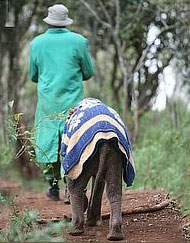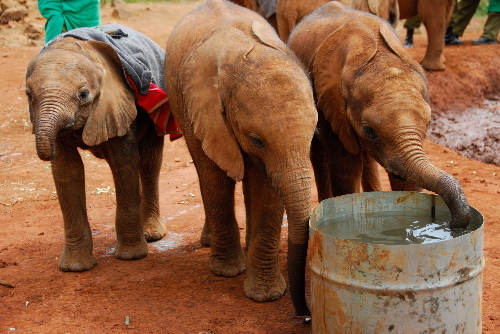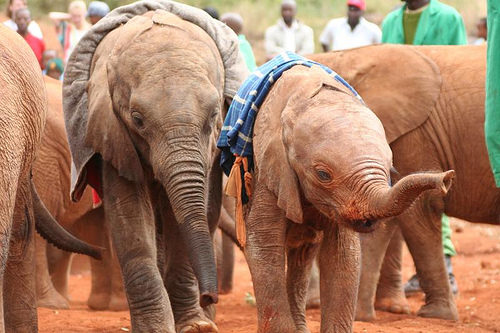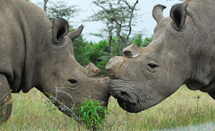How to Foster a Baby Elephant in Kenya
People and organisations across the globe have been supporting the orphaned animals at the David Sheldrick Trust, saving the equivalent of a herd of elephants over the years.
The Orphans’ Project
The trust works in partnership with the Kenya Wildlife Service to protect elephants and rhinos, ensuring their survival. A team of dedicated keepers works around the clock to care for the young orphans. This intensive care is crucial for their survival as the baby elephants need to be fed every three hours. In the wild these calves rely on mother's milk for the first two years of their lives.
This collective effort continues to fund the trust in its work with young elephants and rhinos from all over Kenya. The orphans are rehabilitated at the orphanage in Nairobi National Park and then released back into their natural habitat. The released orphans are transferred to the Tsavo East National Park in southern Kenya, where many have gone on to breed in the wild.
Foster Care
Fostering an orphan costs as little as around R500 (50 USD) a year! When you foster one of the animals the trust sends you photos and an in-depth profile on the orphan, as well as monthly updates on its progress throughout the year. The foster program runs online to keep costs down, keeping you informed about the latest news from the orphanage.
To date the organisation has saved 150 baby elephants, orphaned through poaching, habitat loss, human-wildlife conflict and drought. The orphans are named after the places they are found in, or a local tribe in the area. The funds from fostering one of these baby mammals is used directly for its care, covering the feeding costs, keepers' salaries, vet bills and running expenses at the orphanage.
The rescued orphans range in age from nursery babies and adolescents to older elephants like the 51-year-old Eleanor.
David Sheldrick Trust Videos
See what the rescue and care of a baby elephant involves at the trust:
Watch more videos of the Sheldrick Trust on YouTube.
The Work of the David Sheldrick Trust
This well-established wildlife trust has been around for decades, being founded in 1977 by Dr Dame Daphne Sheldrick. Dame Daphne was the first person to raise an orphaned newborn African elephant and still supervises the running of the trust in Kenya today.
Keepers hand raise the young calves at the orphanage, caring for them and feeding them a milk formula developed by Dame Daphne over almost three decades. Her lifetime of work has also contributed hugely to the field of animal husbandry and the complex task of rearing elephants. Read Daphne's call to action on National Geographic.
The focus of the wildlife trust's work is on releasing the elephants back into the wild in Tsavo East National Park where they become part of free-roaming elephant populations. The gradual process of rehabilitation into the wild is said to take from 8 to 10 years. Over 130 rescued elephants have been rehabilitated and released back into the wild.
More on the David Sheldrick Wildlife Trust
To foster a baby elephant or rhino visit the David Sheldrick Wildlife Trust website.
Check out the David Sheldrick Trust on Facebook or Follow Sheldrick Wildlife on Twitter.
If you're travelling to Kenya then Nairobi is probably on your itinerary. The orphanage is open to visitors and is a real must-see in Nairobi. Over 660 people have rated the David Sheldrick Wildlife Trust as an Excellent place to visit on Tripadvisor. Read about other travellers' experiences at the Sheldrick Elephant Orphanage on Tripadvisor.
For more info and amazing photos check out the National Geographic Sheldrick feature called Orphans No More.
If you liked this post, these trips cover similar ground…
- 4 Day Masai Mara Kenya Safari (Luxury Camping)
- 6 Day Budget Amboseli, Lake Nakuru & Masai Mara Safari
- Best of Kenya & Tanzania Lodge Safari
- 12 Day Kenya Wildlife Safari: Masai Mara & Kenya Game Parks
- 12 Day Masai Mara & Serengeti Safari - Kenya & Tanzania Overland








 Landia is a nature and animal lover. This South African woman avoids crowds seeking out quiet places. She has worked in the African safari industry for over 16 years!
Landia is a nature and animal lover. This South African woman avoids crowds seeking out quiet places. She has worked in the African safari industry for over 16 years!




